Abstract
Fluctuations in response to levodopa are a common and serious complication of long-term levodopa therapy. It may be possible to prolong the effect of each dose of levodopa by retarding the breakdown of dopamine. The selective monoamine oxidase type B inhibitor deprenyl, which is extensively metabolised to amphetamine and methamphetamine, has this effect as well as possible actions on dopamine release and re-uptake. In a double-blind crossover trial against placebo, deprenyl prolonged the action of levodopa and produced an objective improvement in mobility in five of 10 patients with dose-related response swings, and a subjective improvement in a further four patients. In another group of seven patients with random fluctuations in symptoms, only two noted subjective improvement, and there was an apparent increase in the severity of response swings in five patients. Deprenyl exacerbated dyskinesias, but had no serious side-effects. We conclude that deprenyl is unlikely to benefit patients with random response swings, and may cause deterioration in such cases. However, it may be a useful adjuvant in the management of dose-related response fluctuations in patients already on optional levodopa therapy.
Full text
PDF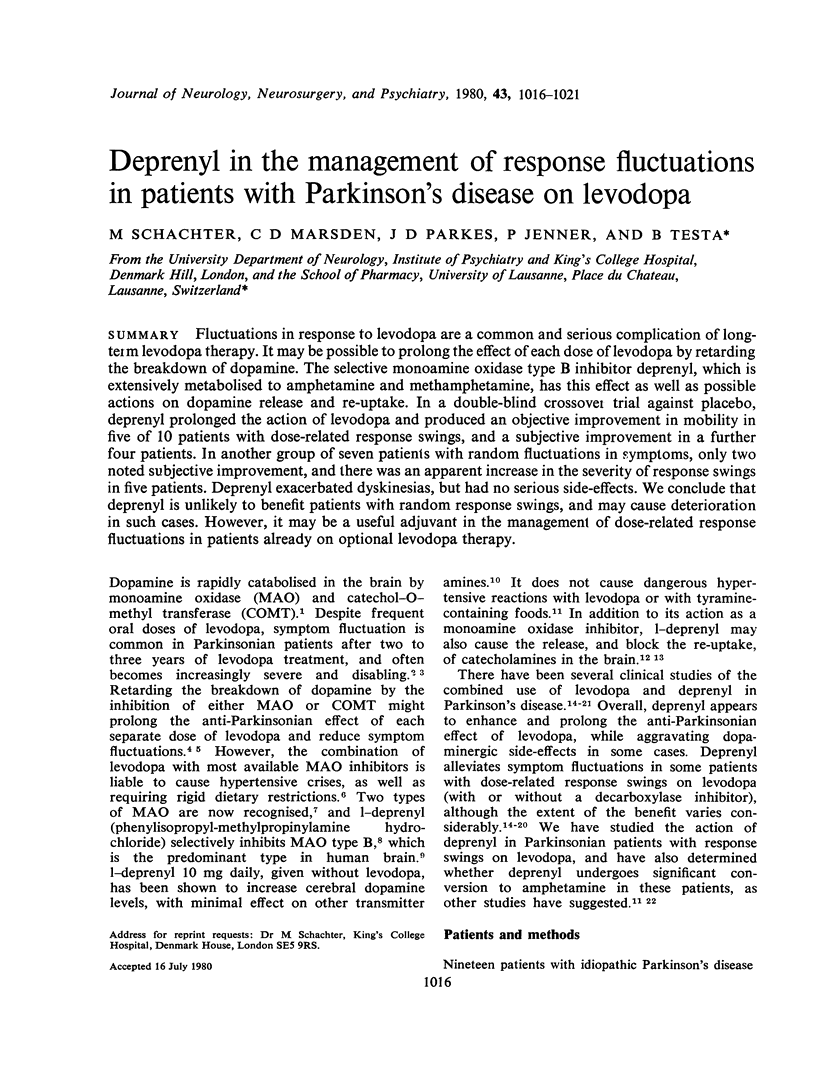
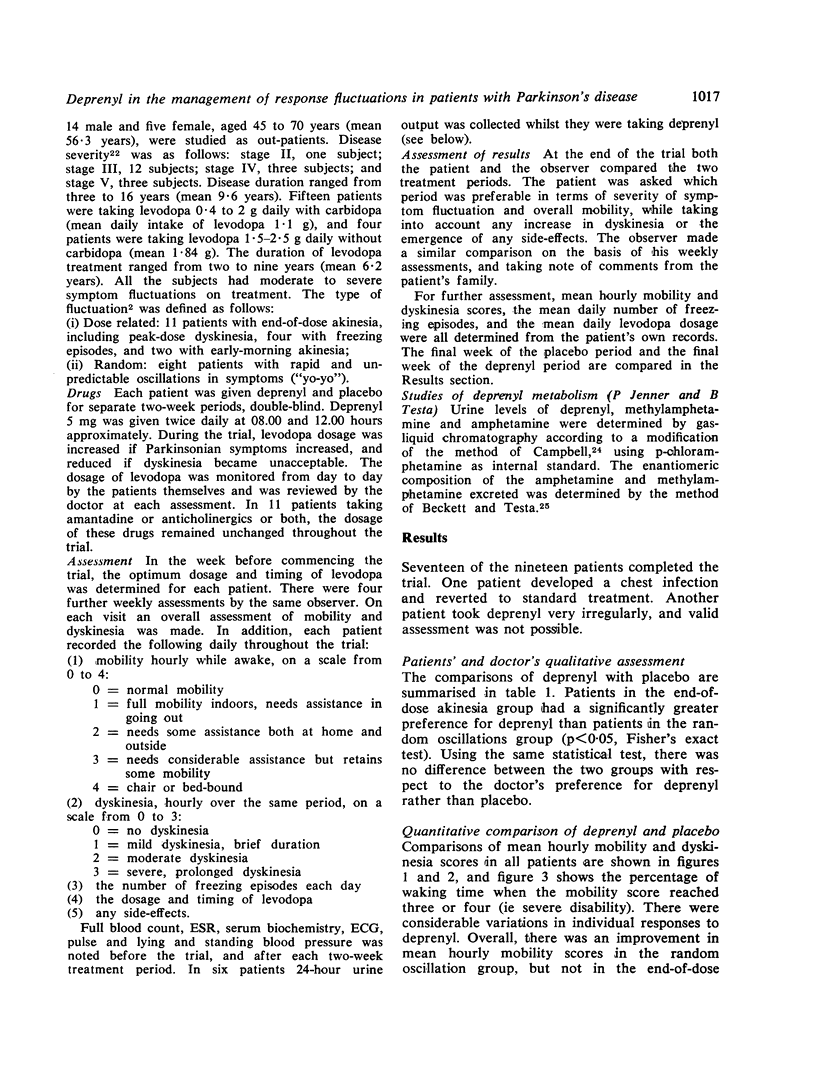
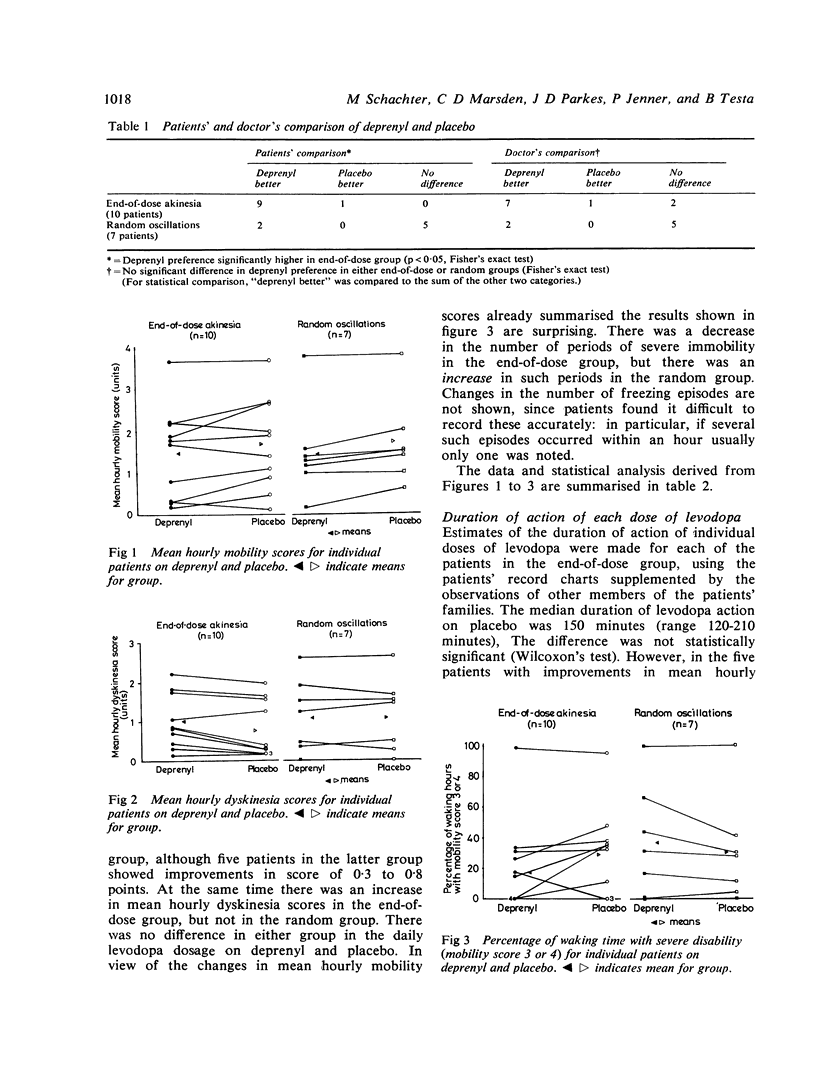
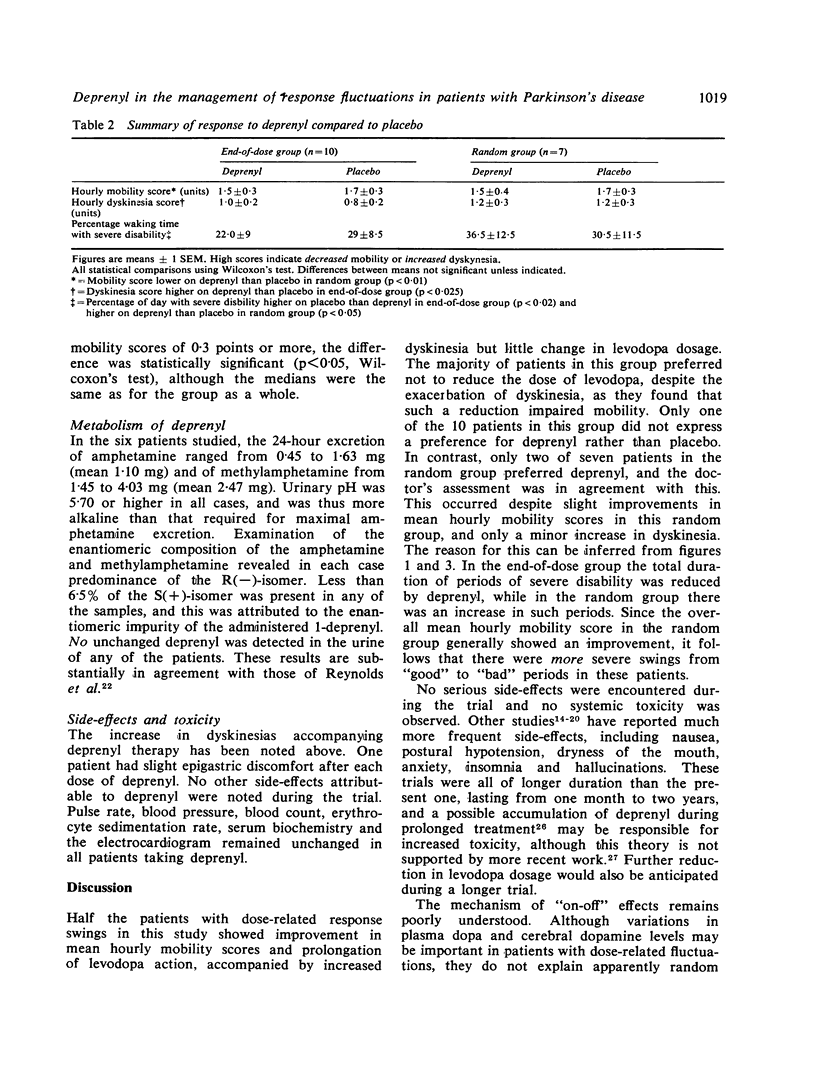
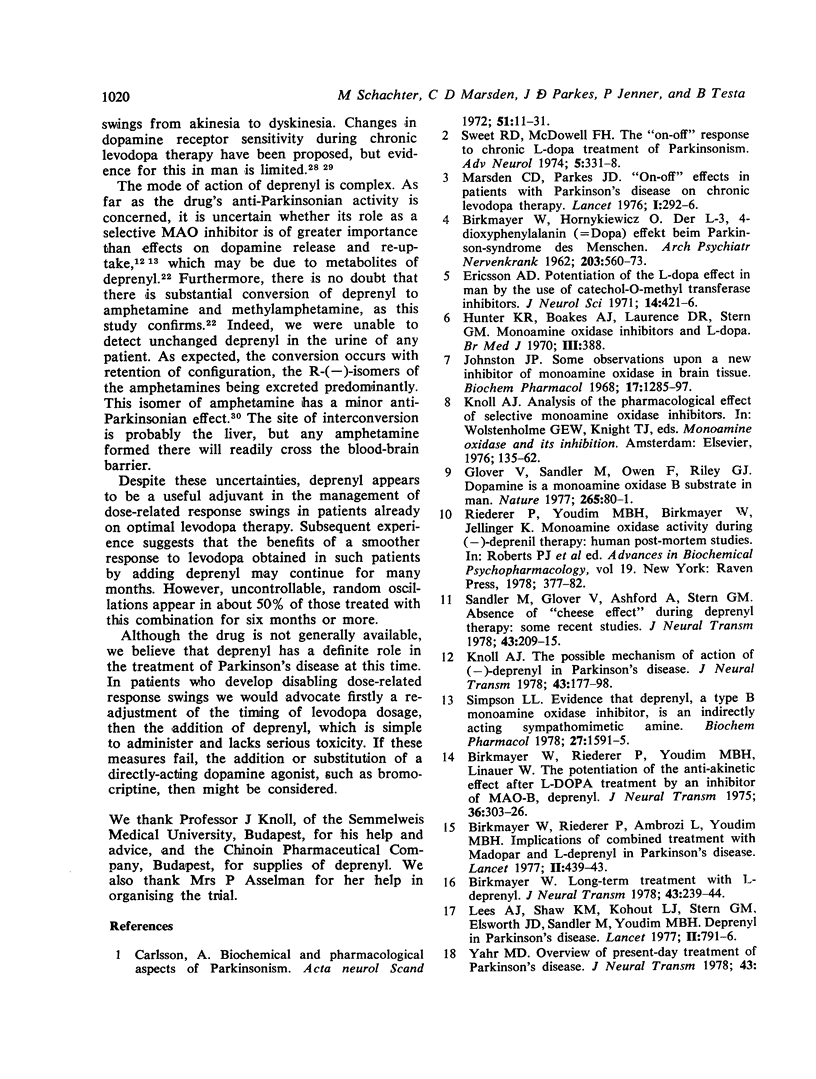
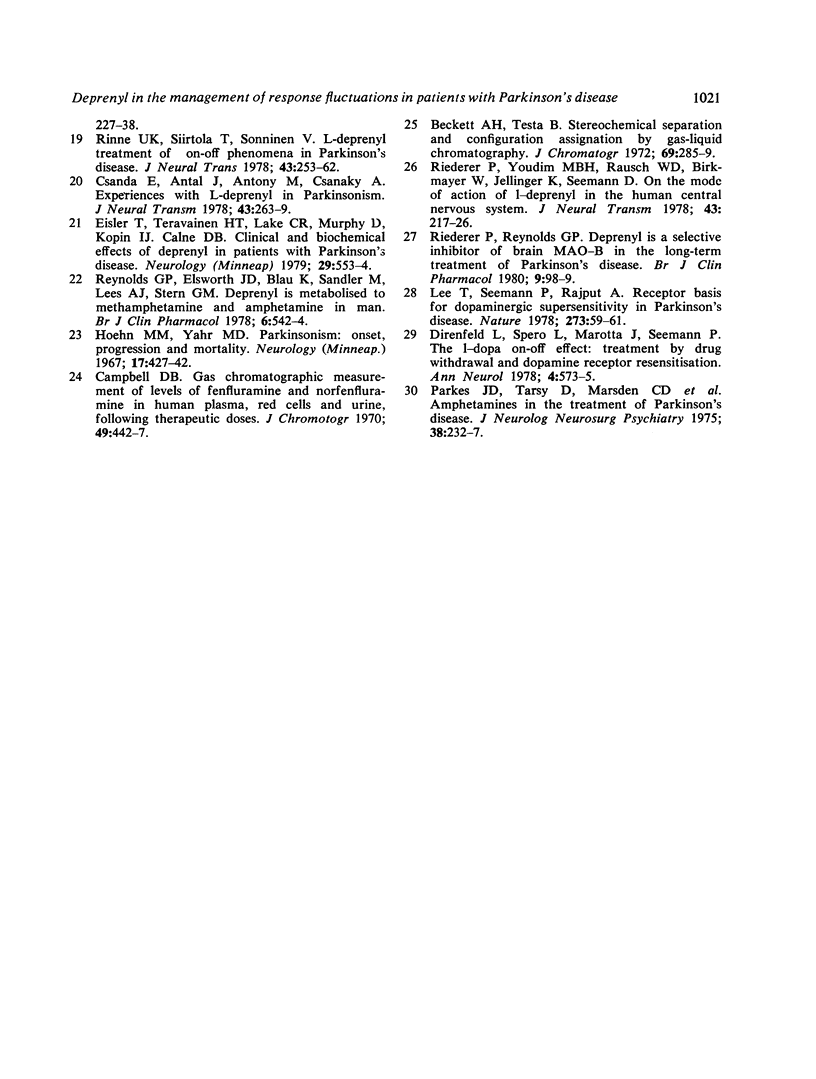
Selected References
These references are in PubMed. This may not be the complete list of references from this article.
- BIRKMAYER W., HORNYKIEWICZ O. [The L-dihydroxyphenylalanine (L-DOPA) effect in Parkinson's syndrome in man: On the pathogenesis and treatment of Parkinson akinesis]. Arch Psychiatr Nervenkr Z Gesamte Neurol Psychiatr. 1962;203:560–574. doi: 10.1007/BF00343235. [DOI] [PubMed] [Google Scholar]
- Beckett A. H., Testa B. Stereochemical separation and configurational assignment by gas-liquid chromatography of N-trifluoroacetyl-L-prolyl amides of asymmetric I-phenylisopropylamines. J Chromatogr. 1972 Jul 5;69(2):285–289. doi: 10.1016/s0021-9673(00)92896-6. [DOI] [PubMed] [Google Scholar]
- Birkmayer W. Long term treatment with L-deprenyl. J Neural Transm. 1978;43(3-4):239–244. doi: 10.1007/BF01246960. [DOI] [PubMed] [Google Scholar]
- Birkmayer W., Riederer P., Ambrozi L., Youdim M. B. Implications of combined treatment with 'Madopar' and L-deprenil in Parkinson's disease. A long-term study. Lancet. 1977 Feb 26;1(8009):439–443. doi: 10.1016/s0140-6736(77)91940-7. [DOI] [PubMed] [Google Scholar]
- Birkmayer W., Riederer P., Youdim M. B., Linauer W. The potentiation of the anti akinetic effect after L-dopa treatment by an inhibitor of MAO-B, Deprenil. J Neural Transm. 1975;36(3-4):303–326. doi: 10.1007/BF01253131. [DOI] [PubMed] [Google Scholar]
- Campbell D. B. Gas chromatographic measurement of levels of fenfluramine and norfenfluramine in human plasma, red cells and urine following therapeutic doses. J Chromatogr. 1970 Jun 24;49(3):442–447. doi: 10.1016/s0021-9673(00)93657-4. [DOI] [PubMed] [Google Scholar]
- Csanda E., Antal J., Antóny M., Csanaky A. Experiences with L-deprenyl in Parkinsonism. J Neural Transm. 1978;43(3-4):263–269. doi: 10.1007/BF01246963. [DOI] [PubMed] [Google Scholar]
- Direnfeld L., Spero L., Marotta J., Seeman P. The L-dopa on-off effect in Parkinson disease: treatment by transient drug withdrawal and dopamine receptor resensitization. Ann Neurol. 1978 Dec;4(6):573–575. doi: 10.1002/ana.410040619. [DOI] [PubMed] [Google Scholar]
- Glover V., Sandler M., Owen F., Riley G. J. Dopamine is a monoamine oxidase B substrate in man. Nature. 1977 Jan 6;265(5589):80–81. doi: 10.1038/265080a0. [DOI] [PubMed] [Google Scholar]
- Hoehn M. M., Yahr M. D. Parkinsonism: onset, progression and mortality. Neurology. 1967 May;17(5):427–442. doi: 10.1212/wnl.17.5.427. [DOI] [PubMed] [Google Scholar]
- Hunter K. R., Boakes A. J., Laurence D. R., Stern G. M. Monoamine oxidase inhibitors and L-dopa. Br Med J. 1970 Aug 15;3(5719):388–388. doi: 10.1136/bmj.3.5719.388. [DOI] [PMC free article] [PubMed] [Google Scholar]
- Johnston J. P. Some observations upon a new inhibitor of monoamine oxidase in brain tissue. Biochem Pharmacol. 1968 Jul;17(7):1285–1297. doi: 10.1016/0006-2952(68)90066-x. [DOI] [PubMed] [Google Scholar]
- Klawans H. L., Jr Effect of vitamin B 6 on levodopa-induced changes in spinal fluid homovanillic acid. J Neurol Sci. 1971 Dec;14(4):421–426. doi: 10.1016/0022-510x(71)90177-8. [DOI] [PubMed] [Google Scholar]
- Knoll J. The possible mechanisms of action of (-)deprenyl in Parkinson's disease. J Neural Transm. 1978;43(3-4):177–198. doi: 10.1007/BF01246955. [DOI] [PubMed] [Google Scholar]
- Lee T., Seeman P., Rajput A., Farley I. J., Hornykiewicz O. Receptor basis for dopaminergic supersensitivity in Parkinson's disease. Nature. 1978 May 4;273(5657):59–61. doi: 10.1038/273059a0. [DOI] [PubMed] [Google Scholar]
- Lees A. J., Shaw K. M., Kohout L. J., Stern G. M., Elsworth J. D., Sandler M., Youdim M. B. Deprenyl in Parkinson's disease. Lancet. 1977 Oct 15;2(8042):791–795. doi: 10.1016/s0140-6736(77)90725-5. [DOI] [PubMed] [Google Scholar]
- Marsden C. D., Parkes J. D. "On-off" effects in patients with Parkinson's disease on chronic levodopa therapy. Lancet. 1976 Feb 7;1(7954):292–296. doi: 10.1016/s0140-6736(76)91416-1. [DOI] [PubMed] [Google Scholar]
- Parkes J. D., Tarsy D., Marsden C. D., Bovill K. T., Phipps J. A., Rose P., Asselman P. Amphetamines in the treatment of Parkinson's disease. J Neurol Neurosurg Psychiatry. 1975 Mar;38(3):232–237. doi: 10.1136/jnnp.38.3.232. [DOI] [PMC free article] [PubMed] [Google Scholar]
- Reiderer P., Reynolds G. P. Deprenyl is a selective inhibitor of brain MAO-B in the long-term treatment of Parkinsons's disease. Br J Clin Pharmacol. 1980 Jan;9(1):98–99. doi: 10.1111/j.1365-2125.1980.tb04805.x. [DOI] [PMC free article] [PubMed] [Google Scholar]
- Reynolds G. P., Elsworth J. D., Blau K., Sandler M., Lees A. J., Stern G. M. Deprenyl is metabolized to methamphetamine and amphetamine in man. Br J Clin Pharmacol. 1978 Dec;6(6):542–544. doi: 10.1111/j.1365-2125.1978.tb00883.x. [DOI] [PMC free article] [PubMed] [Google Scholar]
- Riederer P., Youdim M. B., Rausch W. D., Birkmayer W., Jellinger K., Seemann D. On the mode of action of L-deprenyl in the human central nervous system. J Neural Transm. 1978;43(3-4):217–226. doi: 10.1007/BF01246958. [DOI] [PubMed] [Google Scholar]
- Rinne U. K., Siirtola T., Sonninen V. L-deprenyl treatment of on-off phenomena in Parkinson's disease. J Neural Transm. 1978;43(3-4):253–262. doi: 10.1007/BF01246962. [DOI] [PubMed] [Google Scholar]
- Sandler M., Glover V., Ashford A., Stern G. M. Absence of "cheese effect" during deprenyl therapy: some recent studies. J Neural Transm. 1978;43(3-4):209–215. doi: 10.1007/BF01246957. [DOI] [PubMed] [Google Scholar]
- Simpson L. L. Evidence that deprenyl, A type B monoamine oxidase inhibitor, is an indirectly acting sympathomimetic amine. Biochem Pharmacol. 1978;27(11):1591–1595. doi: 10.1016/0006-2952(78)90490-2. [DOI] [PubMed] [Google Scholar]
- Sweet R. D., McDowell F. H. The "on-off" response to chronic L-DOPA treatment of Parkinsonism. Adv Neurol. 1974;5:331–338. [PubMed] [Google Scholar]


